Terrestrial Invasive Species
 |
 |
 |
 |
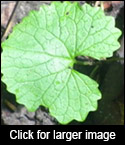 Garlic Mustard (Alliaria petiolata)
Garlic Mustard (Alliaria petiolata)
Growth Form -It is an herbaceous biennial that produces thousands of seeds in its second year and then dies.
Impacts - High quality woodlands, floodplain forests, and disturbed areas
Threats - Garlic mustard is a shade tolerant plant that can have large impacts on the forest floor. It is extremely aggressive colonizer that can outcompete with native vegetation for light, nutrients, soil, moisture and space and is capable of creating monocultures. The diversity of native species is greatly reduced in areas of infestation. It is also found not to appeal to the wildlife as a food source or habitat. Garlic mustard releases a toxin that suppresses the growth of other vegetation. The seed bank can remain viable for up to five years.
Where - Currently on Leech Lake Reservation there is one known population on Onigum Peninsula in the Stony Point Campground. In total, there are approximately 82 acres that are infested.
Note - Photo is taken from Stony Point campground with a close-up on first year basal leaves. Garlic mustard can be identified by crushing the leaf, which gives off a garlic scent.
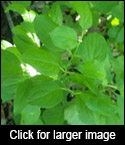 Common Buckthorn (Rhamnus carthartica)
Common Buckthorn (Rhamnus carthartica)
Growth Form - Common buckthorn is a shrub that produces large quantities of fruit every year.
Impacts - It is capable of invading forest ecosystems, wetlands, prairies and other native habitats.
Threats - Common buckthorn is shade tolerant and capable of outcompeting native vegetation for resources and can lead to degradation of wildlife habitat. The fruits contain no nutritional value, stain driveways and are known to be cathartic. Populations of buckthorn can make an impenetrable layer of vegetation that is impossible to navigate. It has also been found to be a host for other pests and because it reduces other vegetation that holds the soil increases in erosion can result. The seed bank can remain viable for up to five years.
Where - Although there are scattered populations located throughout Chippewa National Forest, there are few occurrences on the tribal lands. Typically the populations are found relatively close to urban areas.
Note - Photo was taken near White Oak Lake. The leaf veins run lateral and curve towards the tip.
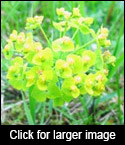 Leafy Spurge (Euphorbia esula)
Leafy Spurge (Euphorbia esula)
Growth Form – Leafy spurge is an herbaceous perennial that reproduces both vegetatively and by seeds, which can produce 140 seeds per stem.
Impacts - It is extremely aggressive that primarily invades non-cropland disturbed environments. Moist and dry prairies and savannas can quickly have native vegetation displaces by leafy spurge.
Threats - Leafy spurge outcompetes with native vegetation for sunlight and nutrients. It also releases a toxin that suppresses the growth of other vegetation. The milky sap is toxic to horse and cattle and can result in skin rashes in sensitive individuals. The seeds remain viable for up to seven years and are dispersed by a seed capsule up to twenty feet from the parent plant.
Where – It has been found throughout Leech Lake Reservation, particularly by wetlands.
Note - Photo was taken on Nary Road.
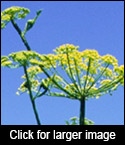
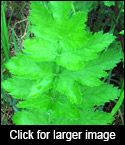 Wild Parsnip (Pastinaca sativa)
Wild Parsnip (Pastinaca sativa)
Growth Form – Wild parsnip is an herbaceous monocarpic perennial, which means it spends one or more years in the rosette stage before bearing numerous seeds one time and then dies.
Impacts - It invades disturbed habitats; these include open dry, moist and wet-moist habitats
Threats - The biggest concern related to wild parsnip is the danger it poses to human health. When sap from a plant comes in contact with sunlight it can cause blisters on the skin. It also outcompetes with native vegetation in disturbed areas. The seed bank remains viable for four years.
Where – It is present throughout Leech Lake Reservation with multiple tribal communities saturated in wild parsnip.
Note - Left photo is a mature wild parsnip while the right photo is an immature plant.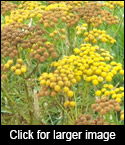 Common Tansy (Tanacetum vulgare)
Common Tansy (Tanacetum vulgare)
Growth Form – Common tansy is an herbaceous perennial that reproduces vegetatively and by seed.
Impacts - It invades disturbed habitats; typically by riverbanks, trails, roadsides, gravel pits, old farmland and pastures. Typically it is found in the same habitat as wild parsnip.
Threats - Common tansy is capable of outcompeting with native vegetation and degrading wildlife habitat in disturbed areas. It is known to be toxic to livestock and hazardous to human health.
Where – There are multiple tribal communities on Leech Lake Reservation that are saturated with common tansy.
Note - The photo in the lower right corner is an immature plant. The larger picture is a mature plant that is beginning to senesce in the fall.
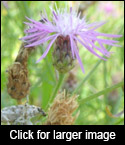 Spotted Knapweed (Centaurea maculosa)
Spotted Knapweed (Centaurea maculosa)
Growth Form – Spotted knapweed is a short-lived perennial that reproduces by seed, which a mature plant can produce thousands of seeds.
Impacts - It is found in disturbed habitats with gravel or sandy soil. It threatens dry prairies, oak and pine barrens, dunes and sandy ridges.
Threats - Spotted knapweed releases a chemical that suppresses the growth of other plants making it able to outcompete. Soil erosion is common in areas with spotted knapweed. It is also known to be a skin irritant.
Where - It is found along most roadways, ditches, ROWs, and areas of high disturbance in Leech Lake Reservation.
Note - The photo in the lower right corner is an immature plant. The picture in the top right corner is close-up of a spotted knapweed head, with a weevil (Cyphocleonus achates) attached. The weevil is a biocontrol for spotted knapweed. The main photo is of a population of spotted knapweed that had a release of biocontrols near U.S Highway 2 NW.
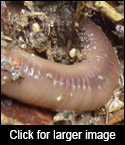 Earthworms
Earthworms
Impacts - Earthworms are the greatest threat to the health of rich northern hardwood forest ecosystems.
Threats - Worms feed on the leaf litter, which is a major component of the duff layer on the forest floor. The duff layer is the natural habitat for many woodland wild flowers, seedlings and wildlife. They can change the composition of soil as well.
Where – They are located throughout Leech Lake Reservation. Since earthworms naturally disperse slowly, new earthworm fronts and invasions are typically the direct result of human activities within the forest.
Contact Us
DRM (218) 335-7400
| Name | Title | Phone |
| Mortensen, Steve | Fish, Wildlife & Plant Resources Program Director | 335-7421 |
| Katie Zlonis | Botanist/Invasive Species Program Manager | 335-7442 |
| Finn, Jon | Fish & Wildlife Field Specialist | 335-7424 |
| White, Gary | Assistant Hatchery Manager | 335-7424 |
| Robinson, Martin | Fish and Wildlife Technician | 335-7424 |















 Division of Resource Management
Division of Resource Management